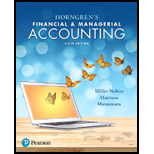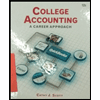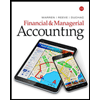
Horngren's Financial & Managerial Accounting (6th Global Edition)
6th Edition
ISBN: 9780134486833
Author: Tracie L. Miller-Nobles, Brenda L. Mattison
Publisher: Pearson Global Edition
expand_more
expand_more
format_list_bulleted
Concept explainers
Question
Chapter B, Problem B.23E
To determine
General Journal: It is a book where all the monetary transactions are recorded in the form of
Special Journal: It is a book where only specific type of monetary transactions such as cash receipts, cash payments, credit sales, and credit purchases are recorded.
To Identify: The errors in special journal
Expert Solution & Answer
Want to see the full answer?
Check out a sample textbook solution
Students have asked these similar questions
Nelson and Murdock, a law firm, sells $8,000,000 of four-year, 8% bonds priced to yield 6.6%. The bonds are dated January 1, 2026, but due to some regulatory hurdles are not issued until March 1, 2026. Interest is payable on January 1 and July 1 each year. The bonds sell for $8,388,175 plus accrued interest.
In mid-June, Nelson and Murdock earns an unusually large fee of $11,000,000 for one of its cases. They use part of the proceeds to buy back the bonds in the open market on July 1, 2026 after the interest payment has been made. Nelson and Murdock pays a total of $8,456,234 to reacquire the bonds and retires them.
Required1. The issuance of the bonds—assume that Nelson and Murdock has adopted a policy of crediting interest expense for the accrued interest on the date of sale.2. Payment of interest and related amortization on July 1, 2026.3. Reacquisition and retirement of the bonds.
Question 20 options:
Paragraph
Nelson and Murdock, a law firm, sells $8,000,000 of four-year, 8% bonds priced to yield 6.6%. The bonds are dated January 1, 2026, but due to some regulatory hurdles are not issued until March 1, 2026. Interest is payable on January 1 and July 1 each year. The bonds sell for $8,388,175 plus accrued interest.
In mid-June, Nelson and Murdock earns an unusually large fee of $11,000,000 for one of its cases. They use part of the proceeds to buy back the bonds in the open market on July 1, 2026 after the interest payment has been made. Nelson and Murdock pays a total of $8,456,234 to reacquire the bonds and retires them.
Required1. The issuance of the bonds—assume that Nelson and Murdock has adopted a policy of crediting interest expense for the accrued interest on the date of sale.2. Payment of interest and related amortization on July 1, 2026.3. Reacquisition and retirement of the bonds.
Question 20 options:
Paragraph
11
Which statement is correct about accounting for financial instruments?
Question 11 options:
All financial instruments are accounted for at fair value through OCI.
All financial instruments are accounted for at amortized cost.
All are accounted for in accordance to their economic substance.
All financial instruments are accounted for at fair value through profit or loss.
Chapter B Solutions
Horngren's Financial & Managerial Accounting (6th Global Edition)
Ch. B - Prob. 1QCCh. B - Prob. 2QCCh. B - Prob. 3QCCh. B - Prob. 4QCCh. B - Prob. 5QCCh. B - Centex Sound Systems purchased merchandise...Ch. B - Every transaction recorded in the cash payments...Ch. B - Prob. 8QCCh. B - Prob. 9QCCh. B - What is an accounting information system (AIS)?
Ch. B - Prob. 2RQCh. B - Explain the three basic components of an...Ch. B - Prob. 4RQCh. B - What is the purpose of a subsidiary ledger?Ch. B - Prob. 6RQCh. B - List the four special journals often used in a...Ch. B - Explain the posting process of the sales journal.Ch. B - Provide some examples of transactions that would...Ch. B - Explain the posting process of the cash payments...Ch. B - When is the general journal used in a manual...Ch. B - Prob. 14RQCh. B - Prob. 15RQCh. B - Prob. 16RQCh. B - How would a business record a sale of services on...Ch. B - Prob. 18RQCh. B - Evaluating features of an effective accounting...Ch. B - Prob. B.2SECh. B - Identifying special journals Use the following...Ch. B - Prob. B.4SECh. B - Prob. B.6SECh. B - Prob. B.8SECh. B - Prob. B.9SECh. B - Prob. B.10SECh. B - Prob. B.11SECh. B - Prob. B.12SECh. B - Prob. B.13SECh. B - Prob. B.14ECh. B - Prob. B.15ECh. B - Prob. B.16ECh. B - Prob. B.17ECh. B - Prob. B.18ECh. B - Prob. B.19ECh. B - Prob. B.20ECh. B - Prob. B.21ECh. B - Prob. B.22ECh. B - Prob. B.23ECh. B - Prob. B.24APCh. B - PC-25A Using the purchases, cash payments, and...Ch. B - Prob. B.26APCh. B - Prob. B.27BPCh. B - PB-28B Using the purchases, cash payments, and...Ch. B - Prob. B.29BPCh. B - Prob. B.30PCCh. B - Prob. B.31PSCh. B - Prob. B.1CPCh. B - Prob. B.1TICh. B - Prob. B.1DCCh. B - Didrikson Rubin, the auditor of Red Barn Farm...Ch. B - Communication Activity C-1 In 150 words or fewer,...
Knowledge Booster
Learn more about
Need a deep-dive on the concept behind this application? Look no further. Learn more about this topic, accounting and related others by exploring similar questions and additional content below.Similar questions
- Which of the following is correct about the difference between basic earnings per share (EPS) and diluted earnings per share? Question 13 options: Basic EPS uses comprehensive income in its calculation, whereas diluted EPS does not. Basic EPS is not a required disclosure, whereas diluted EPS is required disclosure. Basic EPS uses total common shares outstanding, whereas diluted EPS uses the weighted-average number of common shares. Basic EPS is not adjusted for the potential dilutive effects of complex financial structures, whereas diluted EPS is adjusted.arrow_forwardI need help Which entry is correct for recording revenue earned on account?A. Debit Cash, Credit RevenueB. Debit Revenue, Credit Accounts ReceivableC. Debit Accounts Receivable, Credit RevenueD. Debit Unearned Revenue, Credit Casharrow_forwardCan you solve this financial accounting problem using appropriate financial principles?arrow_forward
- 5 What are "zero-coupon bonds"? Question 5 options: Bonds that are sold at a premium. Bonds that are unsecured. Bonds that do not pay interest. Bonds that pay the market rate of interest.arrow_forwardWhich statement is correct about accounting for financial instruments? Question 11 options: All financial instruments are accounted for at fair value through OCI. All financial instruments are accounted for at amortized cost. All are accounted for in accordance to their economic substance. All financial instruments are accounted for at fair value through profit or loss.arrow_forward14 Which statement is correct about "weighted average number of ordinary shares outstanding"? Question 14 options: Treasury shares that are not cancelled are adjusted in this calculation. Treasury shares that are cancelled are adjusted in this calculation. Treasury shares that are repurchased are adjusted in this calculation. Treasury shares are ignored for purposes of this calculation.arrow_forward
- Can you explain the correct approach to solve this financial accounting question?arrow_forward6 Which statement about a "treasury shares" is correct? Question 6 options: No company is permitted to hold treasury shares. Treasury shares have voting rights. Treasury shares receive dividends. There are two methods that can be used to account for treasury shares: the single-transaction method and the two-transaction method.arrow_forwardWhat are "zero-coupon bonds"? Question 5 options: Bonds that are sold at a premium. Bonds that are unsecured. Bonds that do not pay interest. Bonds that pay the market rate of interest.arrow_forward
- Can you help me solve this general accounting question using valid accounting techniques?arrow_forwardNo chatgpt Which entry is correct for recording revenue earned on account?A. Debit Cash, Credit RevenueB. Debit Revenue, Credit Accounts ReceivableC. Debit Accounts Receivable, Credit RevenueD. Debit Unearned Revenue, Credit Casharrow_forwardCan you explain this general accounting question using accurate calculation methods?arrow_forward
arrow_back_ios
SEE MORE QUESTIONS
arrow_forward_ios
Recommended textbooks for you
- Principles of Accounting Volume 1AccountingISBN:9781947172685Author:OpenStaxPublisher:OpenStax College
 College Accounting (Book Only): A Career ApproachAccountingISBN:9781337280570Author:Scott, Cathy J.Publisher:South-Western College Pub
College Accounting (Book Only): A Career ApproachAccountingISBN:9781337280570Author:Scott, Cathy J.Publisher:South-Western College Pub  College Accounting (Book Only): A Career ApproachAccountingISBN:9781305084087Author:Cathy J. ScottPublisher:Cengage Learning
College Accounting (Book Only): A Career ApproachAccountingISBN:9781305084087Author:Cathy J. ScottPublisher:Cengage Learning Financial AccountingAccountingISBN:9781337272124Author:Carl Warren, James M. Reeve, Jonathan DuchacPublisher:Cengage Learning
Financial AccountingAccountingISBN:9781337272124Author:Carl Warren, James M. Reeve, Jonathan DuchacPublisher:Cengage Learning Financial & Managerial AccountingAccountingISBN:9781337119207Author:Carl Warren, James M. Reeve, Jonathan DuchacPublisher:Cengage Learning
Financial & Managerial AccountingAccountingISBN:9781337119207Author:Carl Warren, James M. Reeve, Jonathan DuchacPublisher:Cengage Learning


Principles of Accounting Volume 1
Accounting
ISBN:9781947172685
Author:OpenStax
Publisher:OpenStax College

College Accounting (Book Only): A Career Approach
Accounting
ISBN:9781337280570
Author:Scott, Cathy J.
Publisher:South-Western College Pub

College Accounting (Book Only): A Career Approach
Accounting
ISBN:9781305084087
Author:Cathy J. Scott
Publisher:Cengage Learning

Financial Accounting
Accounting
ISBN:9781337272124
Author:Carl Warren, James M. Reeve, Jonathan Duchac
Publisher:Cengage Learning

Financial & Managerial Accounting
Accounting
ISBN:9781337119207
Author:Carl Warren, James M. Reeve, Jonathan Duchac
Publisher:Cengage Learning
The accounting cycle; Author: Alanis Business academy;https://www.youtube.com/watch?v=XTspj8CtzPk;License: Standard YouTube License, CC-BY